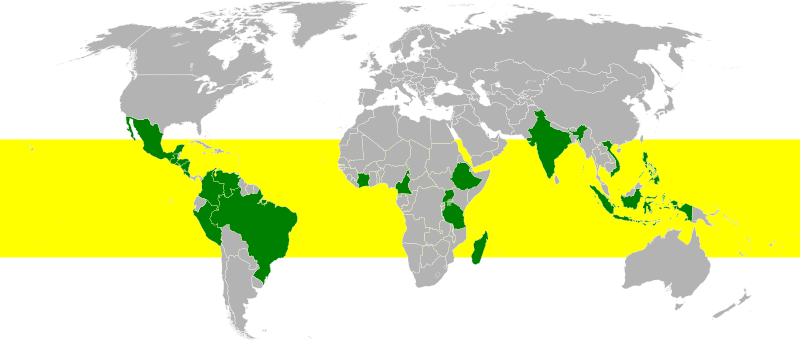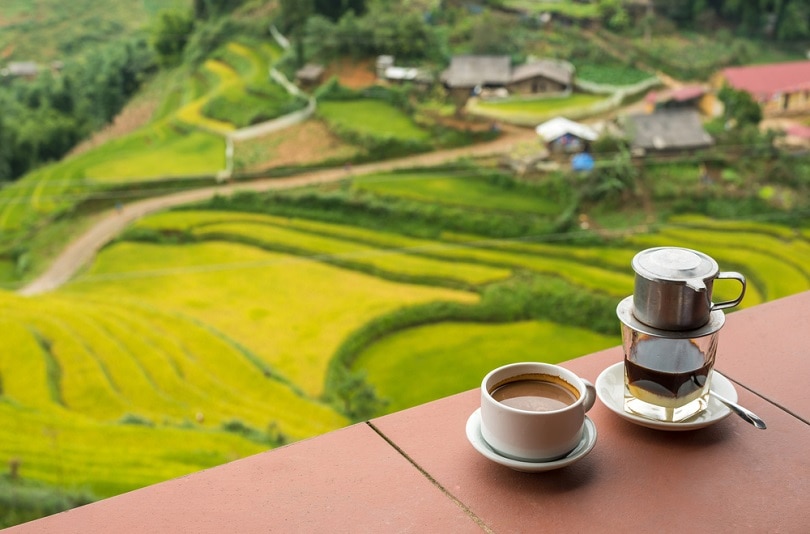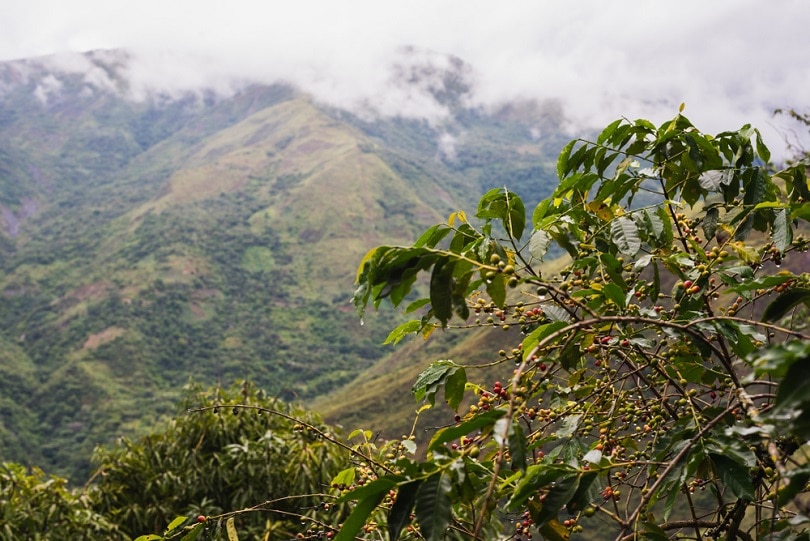
Coffee isn’t easy to grow. The world’s favorite caffeine-packed fruit seed is a finicky crop that doesn’t do well when the conditions aren’t just right. If it’s too cold, too dry, if the soil doesn’t have enough nitrogen, or if the humidity is too low, coffee plants won’t grow to their full potential. It is a disappointing fact for wannabe coffee farmers, but, unfortunately, coffee plants simply won’t grow outside of a very particular climate.
So, where does coffee grow? If you were paying attention, you might have picked up on some clues. Coffee trees like hot, damp climates, nutrient-dense soil, and they do better at higher elevations. It turns out there is a band of latitudes between the Tropics of Cancer and Capricorn where ideal conditions exist for growing coffee. That band has affectionately become known as the coffee belt.
If you look at the above coffee belt map, you’ll quickly notice that all of the major coffee-producing countries lie between the two tropics. It’s not a coincidence that countries like Brazil and Colombia in South America, Ethiopia and Burundi in Africa, and Indonesia and India in Asia all fall in the sweet spot for coffee production. Their global dominance in the coffee industry is only possible because they have an ideal environment for cultivating coffee.

The 4 Reasons the Coffee Belt is the Ideal Coffee Growing Environment
1. Temperature

The first ingredient required to grow excellent coffee is temperature. Coffee plants don’t thrive in cool climates, instead favoring temperatures between 73ºF and 82ºF. This range overlaps nicely with the 70ºF–80ºF average year-round temperature in the tropics.
2. Humidity

Another important factor for growing coffee is humidity. For optimal results, coffee plants need between 50% and 70% relative humidity consistently. For reference, the most humid tropical climates have an average relative humidity that hovers around 80%. A dry climate like the desert of Arizona has an average relative humidity of around 40%, half as much as a tropical climate.
3. Soil

Soil quality isn’t a feature unique to the climate and ecosystems of the coffee belt, but many coffee belt countries like Ethiopia, Costa Rica, or Nicaragua also have the right type of soil in abundance. Coffee thrives in nitrogen-rich soil, and regions with high nutrient density—like volcanic runoff areas—are well-suited for growing high-quality coffee.
4. Elevation

A lesser-known fact about growing coffee is that some coffee, like Arabica, does better at higher elevations. High-quality specialty coffee is usually grown between 3,500 feet and 5,000 feet above sea level. Some varieties do not do well at high altitudes, but they are the exception rather than the rule.
There are several reasons for this, including greater temperature variation between day and night, which helps the coffee fruit ripen more quickly. Mountainous environments also tend to have alternating periods of extensive rainfall followed by stretches of copious direct sunlight, which also helps coffee crops mature.
Coffee grown at higher elevations is generally higher quality and more sought after by specialty coffee enthusiasts. High-altitude coffee is brighter and fruitier than coffee produced at lower altitudes, and it also stays fresh for longer thanks to its higher density.
If you want to try high-altitude-grown coffee, be prepared to spend quite a bit more than you would on regular coffee. Farmable land is scarce at higher elevations, and the farming process is more labor-intensive and difficult due to the remote and unforgiving terrain. Those considerations combine with the taste and storage benefits of high-altitude coffee to raise the price substantially.

Conclusion
The coffee belt is another name for the swath of Earth located between the Tropics of Cancer and Capricorn, where ideal conditions for growing coffee exist. Virtually every major coffee-producing country sits in the coffee belt, and we’re willing to bet most people—even the most avid coffee lovers—couldn’t name a single country outside the coffee belt that contributes significant volume to global coffee production.
Coffee is a complicated crop to cultivate and requires precise temperature, humidity, and soil quality to grow to its full potential. If any piece of the puzzle is missing, the coffee beans produced won’t be good enough to compete for the discerning coffee-drinking customer.
See Also:
- How to Grow a Coffee Plant: Everything You Need to Know
- 5 Surprising Coffee Myths Debunked
- Where Do Coffee Beans Come From? The Seed to Cup Process
Featured Image Credit: Toniflap, Shutterstock















